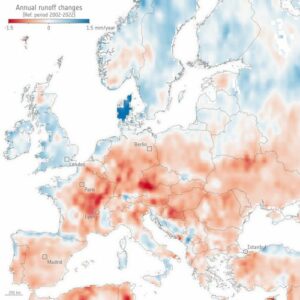Runoff: not as you might think

Runoff and river discharge are important components in Earth’s water cycle, but as climate change tightens its grip, heatwaves and instances of drought are increasingly hitting the headlines. One would assume that this hotter weather leads to reduced water runoff, but an innovative way of using information from satellites suggests that this isn’t always the case.

Annual runoff trend from 2002 to 2022
Runoff occurs when there is precipitation, but the soil is saturated and has lost its capacity to soak up any more water. The water is then forced to flow over land or through channels until it reaches a stream or a river. Rivers and lakes are a result of runoff.
River discharge is typically obtained by using hydrological or land-surface models, which require accurate observations of precipitation and evaporation. But these models may need approximations that can introduce uncertainties into model predictions.
Hydrologists are always looking for ways of reducing uncertainties so as to improve runoff and river discharge predictions: an innovative approach comes from Italian researchers of the Istituto di ricerca per la protezione idrogeologica (Cnr-Irpi) of the National Research Council of Italy. Researcher Stefania Camici says: “Our stream approach is innovative because it takes advantage of the new possibilities offered by satellite observations. From space, we can obtain information on soil moisture content and terrestrial water storage that is not available from ground-based monitoring networks. By using these observations in a newly-designed hydrological model, we have been able to develop a robust and reliable system for predicting runoff and river discharge.”
The model has already been applied to a number of large river basins, in different parts of the world and the first results are now available for Europe.
The large map above shows annual runoff trend over 20 years, between 2002 and 2022. This throws up some intriguing findings.
It is evident that runoff over central Europe – Germany, France, Austria, Czech Republic – is strongly decreasing, as one would expect given drought conditions over the last years. Runoff is also decreasing in parts of southern Europe, such as Spain and Greece.
On the other hand, runoff is increasing in Denmark and northern Europe.
But curiously, runoff is also increasing parts of southern Europe, including central Italy, Sardinia, Corsica and the in the Pyrenees.
Per informazioni:
Stefania Camici
CNR – Istituto di ricerca per la protezione idrogeologica
Via Madonna Alta 126, Perugia
stefania.camici@irpi.cnr.it
Vedi anche:


